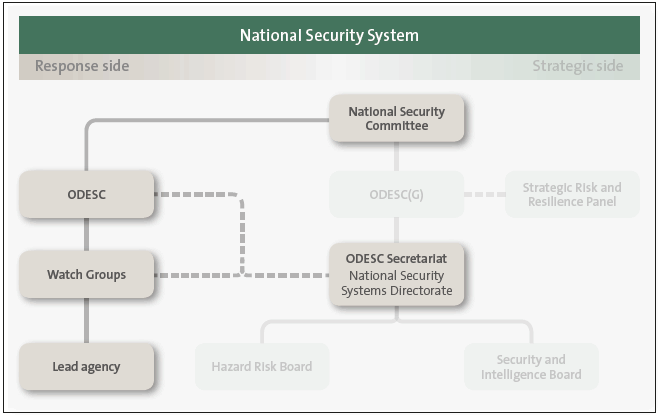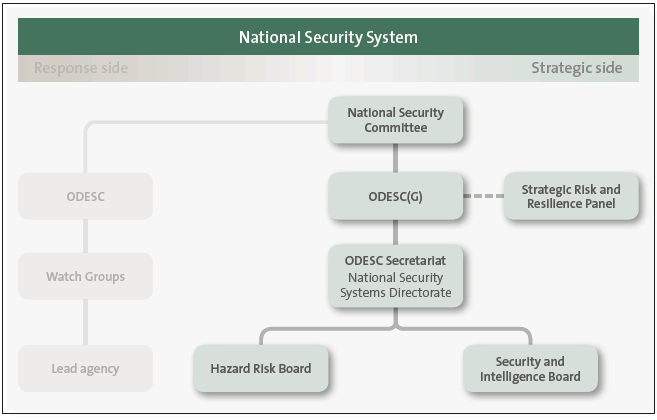Part 2: The National Security System and how it is governed
2.1
In this Part, we discuss:
- what national security is;
- the governance arrangements for responses to national security events and emergencies – the response side of the System; and
- the governance arrangements for managing national security risks and national resilience-building – the strategic side of the System.
What is national security?
2.2
DPMC's National Security System Handbook describes national security as the condition that permits the citizens of a state to go about their daily business confidently and free from fear, and to be able to make the most of opportunities to advance their way of life. This condition requires a resilient national security system that is:
- well led;
- strategically focused;
- co-ordinated;
- cost-effective;
- accountable;
- geared to risk management; and
- responsive to any challenges that arise.
2.3
New Zealand takes an "all hazards, all risks" approach to national security. This means that the System includes all risks to national security, whether internal or external, human or natural. Such risks can include state and armed conflict, transnational organised crime, cyber-security incidents, natural hazards, biosecurity events, and pandemics. In New Zealand, national security is centrally co-ordinated.
Governance arrangements for the response side
2.4
When the System is activated in response to a national security event or emergency, the response side governs and manages the response (see Figure 3). This happened, for example, with the threat to contaminate infant milk formula with 1080 poison, the TS Rena grounding, and the Pike River Mine disaster.
Figure 3
The response side of the National Security System

2.5
The response side of the System has been in place since 1987. It has a simple structure that has not changed significantly since it was introduced. There are three levels of governance in the response side of the System:
- The National Security Committee is chaired by the Prime Minister. It oversees the national security and intelligence sector, including policy and legislative proposals. The Committee co-ordinates and directs national responses to crises or circumstances (either domestic or international) that affect national security. It includes Ministers with relevant portfolio responsibilities. The National Security Committee reports to Cabinet and has the power to act without further reference to Cabinet in some circumstances.
- The Officials' Committee for Domestic and External Security Coordination (ODESC) is chaired by the Chief Executive of DPMC and involves chief executives from a range of agencies, selected by the Chairperson as circumstances require. ODESC's role is to provide strategic direction and co-ordination for the all-of-government response to an event. ODESC reports to the National Security Committee.
- Watch Groups are usually chaired by DPMC's Deputy Chief Executive Security and Intelligence or a delegated official from the Directorate and are made up of senior officials from relevant agencies. DPMC may call a Watch Group to monitor a potential, developing, or actual crisis. Watch Groups are responsible for ensuring ongoing, high-level co-ordination between agencies and for co-ordinating assessments and advice up to ODESC.
2.6
The aim of the response structure is to provide a co-ordinated, all-of-government response that identifies and manages risks, is timely, minimises harm, and uses resources appropriately.
2.7
DPMC activates the System at the request of, or in discussion with, the chief executive of the lead agency.3 There are several reasons why the System can be activated. According to the National Security System Handbook, these include:
- increasing risk, or a disaster or crisis, affects New Zealand interests;
- when active or close co-ordination or extensive resources are required;
- when the crisis might involve risk to New Zealand's international reputation;
- when an issue is of large scale, high intensity, or great complexity;
- to assist with co-ordinating multiple, smaller, simultaneous events; and
- to assist with the early co-ordination of an emerging issue that might meet the above criteria in the future and would benefit from proactive management.
Governance arrangements for the strategic side
2.8
The strategic side of the System focuses on risk management and building national resilience (see Figure 4). This structure has existed since late 2013, and DPMC describes it as a work in progress.
Figure 4
The strategic side of the National Security System

2.9 The strategic side of the System includes several boards, committees, and subcommittees and working groups. We looked at the governance boards on this side of the System. They are:
- the Officials Committee for Domestic and External Security Coordination (Governance), or ODESC(G);
- the Security and Intelligence Board;
- the Hazard Risk Board; and
- the Strategic Risk and Resilience Panel.
2.10
ODESC(G) is the primary governance board overseeing New Zealand's national resilience-building and risk management. ODESC(G) is a different board to the group of officials that meet as ODESC in a response. The similarity of the names causes confusion for some people involved in the System.
2.11
The purpose of ODESC(G) is to ensure that capability and systems are in place to identify major risks facing New Zealand and that suitable arrangements are made throughout government to efficiently and effectively mitigate and manage those risks. ODESC(G) is chaired by the Chief Executive of DPMC. Its members include DPMC's Deputy Chief Executive Security and Intelligence, the Solicitor-General, and Chief Executives from the State Services Commission, the Treasury, the New Zealand Police, the New Zealand Defence Force, the Ministry of Foreign Affairs and Trade, the Ministry for Primary Industries, the Ministry of Defence, and the Ministry of Health. ODESC(G) reports to the National Security Committee.
2.12
The Security and Intelligence Board focuses on external threats and intelligence issues. Its purpose is to build a high-performing, cohesive, and effective security and intelligence sector through appropriate governance, alignment, and prioritisation of investment, policy, and activity. It is chaired by DPMC's Deputy Chief Executive Security and Intelligence, and its members include Chief Executives from DPMC, the Government Communications Security Bureau, the Ministry of Foreign Affairs and Trade, the Ministry of Defence, New Zealand Customs, the New Zealand Defence Force, the New Zealand Police, the Ministry of Business, Innovation and Employment, and the New Zealand Security Intelligence Service. The Security and Intelligence Board reports to ODESC(G).
2.13
The sorts of matters that the Security and Intelligence Board considers include:
- the national security workforce;
- implementing New Zealand's intelligence priorities;
- New Zealand's overseas peacekeeping commitments;
- intelligence and security relationships; and
- counter-terrorism.
2.14
The Hazard Risk Board focuses on a range of hazards and risks, and also has a focus on the overall health of the System. According to the National Security System Handbook, the purpose of the Hazard Risk Board is "to build a high performing and resilient National Security System able to manage civil contingencies and hazard risks through appropriate governance, alignment, and prioritisation of investment, policy and activity".
2.15
The Hazard Risk Board is also chaired by DPMC's Deputy Chief Executive Security and Intelligence, and its members include Chief Executives or their delegates from DPMC, the New Zealand Police, the Ministry of Health, the Ministry for Primary Industries, the Ministry of Transport, the New Zealand Defence Force, the Ministry of Foreign Affairs and Trade, the New Zealand Fire Service, and the Ministry of Civil Defence and Emergency Management.
2.16
The sorts of matters that the Hazard Risk Board considers include:
- managing major transport risks and clarifying national arrangements for managing a major transport accident;
- search and rescue capabilities, limitations, readiness, and risks;
- security risks of highly hazardous substances;
- enabling effective oversight of the System's capability, including professional development and the National Exercise Programme; and
- improvements to the System after Operation Concord.
2.17
The Strategic Risk and Resilience Panel is an independent panel that was set up to provide challenge and advice to ODESC(G). According to the National Security System Handbook, the purpose of the Strategic Risk and Resilience Panel is "to provide a rigorous and systematic approach to anticipating and mitigating strategic national security risks."
2.18
The Strategic Risk and Resilience Panel has nine members who were selected by the Chairperson of ODESC(G) for their expertise in a wide range of areas in both the public and private sectors. Panel members are independent and do not represent any agencies.
3: For any national security risk (or major element of such a risk), a lead agency is identified. The lead agency is the agency with the primary mandate for managing a particular hazard or risk.

